
Sulu, officially the Province of Sulu, is a province of the Philippines in the Sulu Archipelago and part of the Bangsamoro Autonomous Region in Muslim Mindanao (BARMM).

A pump-jet, hydrojet, or water jet is a marine system that produces a jet of water for propulsion. The mechanical arrangement may be a ducted propeller, a centrifugal pump, or a mixed flow pump which is a combination of both centrifugal and axial designs. The design also incorporates an intake to provide water to the pump and a nozzle to direct the flow of water out of the pump.

A fishing trawler is a commercial fishing vessel designed to operate fishing trawls. Trawling is a method of fishing that involves actively dragging or pulling a trawl through the water behind one or more trawlers. Trawls are fishing nets that are pulled along the bottom of the sea or in midwater at a specified depth. A trawler may also operate two or more trawl nets simultaneously.

Seine fishing is a method of fishing that employs a surrounding net, called a seine, that hangs vertically in the water with its bottom edge held down by weights and its top edge buoyed by floats. Seine nets can be deployed from the shore as a beach seine, or from a boat.
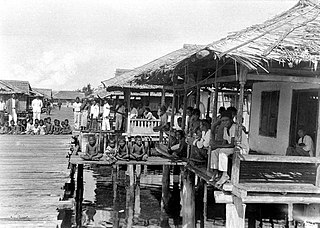
The Bajo, Bajonese, Bajonesian, or Wajo, Wajonese are the indigenous Indonesian ethnic group native to the Bajo Island of Lesser Sunda Islands in Indonesia. These ethnic group can be found all across the Flores Sea to the northeastern Bali Sea, and some have established permanent settlements in the southern of Sulawesi where they are locally known as the Wajo Bugis due to their close historical relation with the Bugis ethnic group.

The Sama-Bajau include several Austronesian ethnic groups of Maritime Southeast Asia. The name collectively refers to related people who usually call themselves the Sama or Samah ; or are known by the exonym Bajau. They usually live a seaborne lifestyle and use small wooden sailing vessels such as the perahu, djenging (balutu), lepa, and vinta (pilang). Some Sama-Bajau groups native to Sabah are also known for their traditional horse culture.

Mabul is a small island near the southeastern coast of Sabah in Malaysia. The island has been a fishing village since the 1970s. After the 1990s, Mabul gained popularity with scuba divers due to its proximity to Sipadan island.
The Scottish east coast fishery has been in existence for more than a thousand years, spanning the Viking Age right up to the present day.

The vinta is a traditional outrigger boat from the Philippine island of Mindanao. The boats are made by Sama-Bajau, Tausug and Yakan peoples living in the Sulu Archipelago, Zamboanga peninsula, and southern Mindanao. Vinta are characterized by their colorful rectangular lug sails (bukay) and bifurcated prows and sterns, which resemble the gaping mouth of a crocodile. Vinta are used as fishing vessels, cargo ships, and houseboats. Smaller undecorated versions of the vinta used for fishing are known as tondaan.

A fishing vessel is a boat or ship used to catch fish and other valuable nektonic aquatic animals in the sea, lake or river. Humans have used different kinds of surface vessels in commercial, artisanal and recreational fishing.
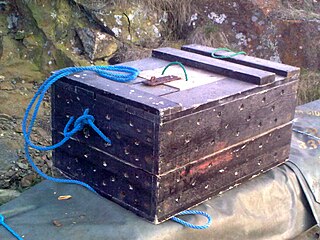
A corf also spelt corve is a container of wood, net, chicken wire, metal or plastic used to contain live fish, eels or crustaceans underwater, at docks or in fishing boats.

The Sama–Bajaw languages are a well-established group of languages spoken by the Sama-Bajau peoples of the Philippines, Indonesia and Malaysia.
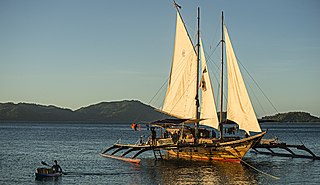
A balangay, or barangay, is a type of lashed-lug boat built by joining planks edge-to-edge using pins, dowels, and fiber lashings. They are found throughout the Philippines and were used largely as trading ships up until the colonial era. The oldest known balangay are the Butuan boats, which have been carbon-dated to 320 AD and were recovered from several sites in Butuan, Agusan del Norte.
The BRP Nestor Reinoso (PC-380) is the tenth ship of the Jose Andrada class coastal patrol boats of the Philippine Navy. It is part of the second batch of its class ordered through US Foreign Military Sales (FMS) in 1993, and was commissioned with the Philippine Navy on 1 June 1995.
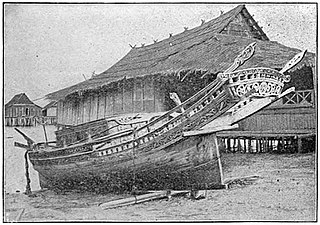
Lepa, also known as lipa or lepa-lepa, are indigenous ships of the Sama-Bajau people in Indonesia, the Philippines, and Malaysia. They were traditionally used as houseboats by the seagoing Sama Dilaut. Since most Sama have abandoned exclusive sea-living, modern lepa are instead used as fishing boats and cargo vessels.

Bangka are various native watercraft of the Philippines. It originally referred to small double-outrigger dugout canoes used in rivers and shallow coastal waters, but since the 18th century, it has expanded to include larger lashed-lug ships, with or without outriggers. Though the term used is the same throughout the Philippines, "bangka" can refer to a very diverse range of boats specific to different regions. Bangka was also spelled as banca, panca, or panga in Spanish. It is also known archaically as sakayan.

The 2019 Reed Bank incident occurred when F/B Gem-Ver, a Philippine fishing boat anchored in Reed Bank in the South China Sea, sank after it was rammed by a Chinese vessel, Yuemaobinyu 42212, during the early morning hours of 9 June 2019. The stricken vessel's crew was later rescued by a Vietnamese fishing vessel.
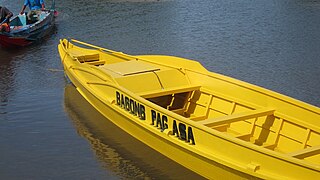
Tiririt, also known as taririt or papet, is a type of small dinghy of the Sama-Bajau and Tausug people of the Philippines. It is commonly motorized. It is usually carried aboard larger motherships and assists in transporting passenger and cargo to the shore, as well as in towing the boat to port. However, it can also be used as a small inter-island transport. It is roughly leaf-shaped in outline with a distinctive hump-backed side-profile. The prow and stern can sometimes rise up into arcs. It normally has no outriggers.
Junkung, also spelled jungkung or jungkong, is a small wooden sail to motorized boat used by Tausug, Sama-Bajau, and Yakan people of the Philippines. It is a fast cargo ship and is commonly used as a smuggling vessel in the maritime borders of the Philippines, Sabah, Malaysia and Eastern Indonesia. They are also sometimes used by pirates and Abu Sayyaf terrorists in and around the Sulu Sea.
Kulibo, or Kulibu, is a small wooden motorized traditional fishing boat with short double outriggers used by Tausug, Sama-Bajau, and Yakan people of the Philippines. Characterized as "ring-netters," they are classified as "small-scale commercial fishing vessels." This type of boat is commonly used by fisherfolk in Tawi-Tawi to catch small fishes, usually during the night.



















